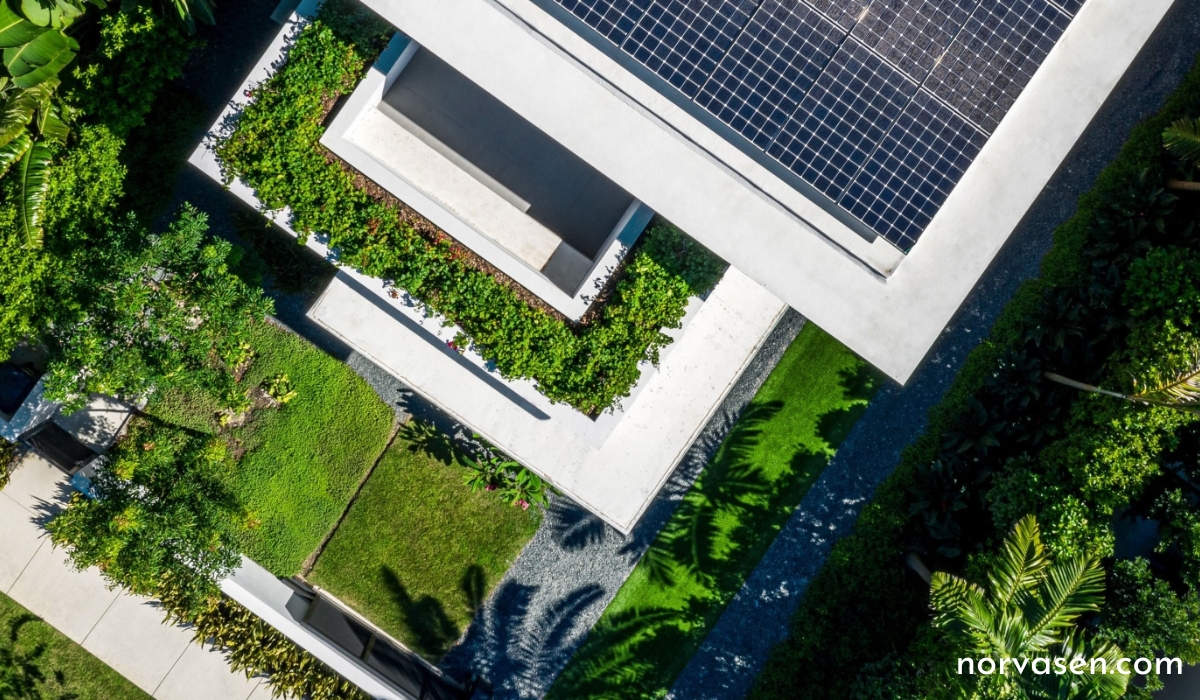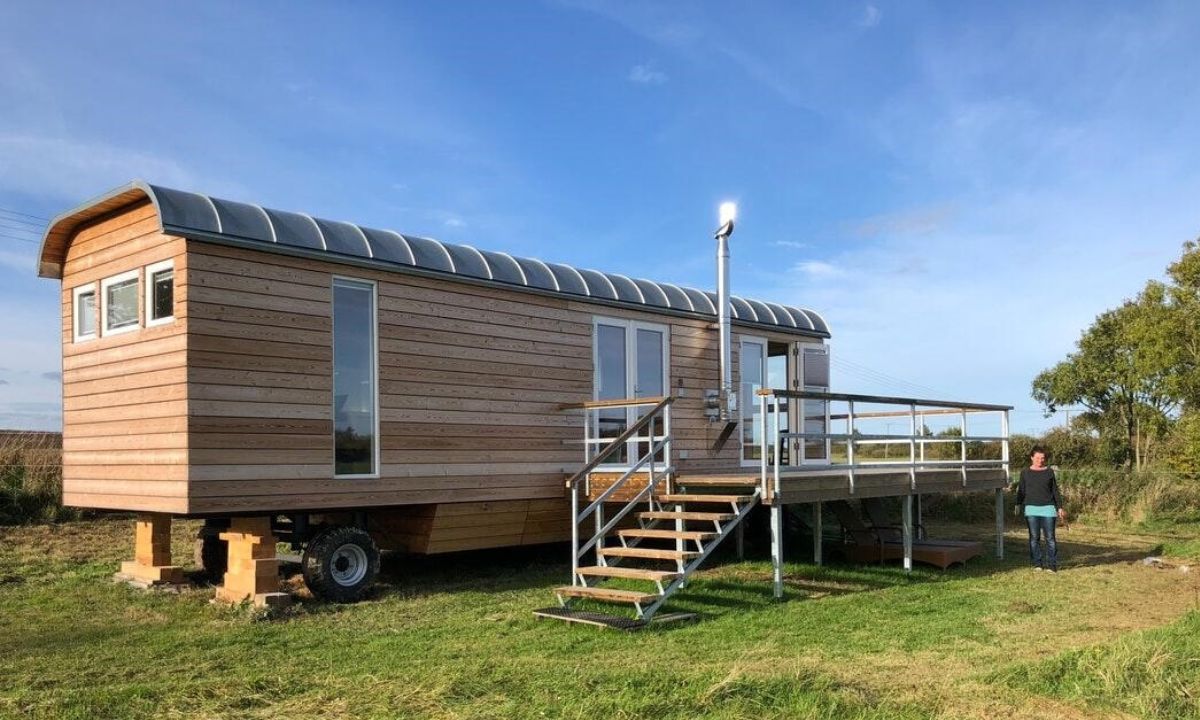Home Improvement
Sustainable Property Management: Eco-Friendly Practices for Modern Buildings

Sustainability is becoming more and more important, and property management is no different. Imagine structures that are not just fashionable and useful but also environmentally responsible. This blog post will serve as your manual for making those exact structures.
We’ll look at a variety of green strategies you may use in your contemporary property management plan, such as water- and energy-saving fixtures and lighting.
The Three Pillars of Sustainability
Sustainable property management involves more than just reducing your environmental impact. This all-encompassing approach considers three primary pillars:
- Environmental: This refers to actions taken to lessen the building’s impact on the environment, such as employing eco-friendly materials and consuming less energy and water.
- Economic: Using sustainable techniques may save a lot of money on maintenance and utilities. Furthermore, homes with green features frequently fetch higher rates and reach a wider clientele.
- Social: Providing renters with hygienic and cozy living areas enhances their general contentment and well-being while building a sense of community.
Implementing Eco-Friendly Practices
These are some essential procedures for sustainable property management to take into account:
1. Energy Efficiency
Making the switch to LED lights, setting up smart thermostats, and doing routine HVAC maintenance will all greatly cut down on energy use. Think about putting in place building automation systems that optimize energy consumption according to occupancy and current circumstances.
To produce clean power and lessen dependency on the grid, invest where it is practical in renewable energy sources like solar panels and wind turbines.
Ongoing energy audits can pinpoint inefficient areas and offer practical advice for enhancement. Energy consumption may be significantly decreased by installing energy-efficient windows, upgrading insulation, and plugging leaks. If you need help with this, a professional property management company has the expertise to put these practices into action.
2. Conserving Water
Water is essential to our planet, and each drop counts. We all have a vital role to play in making sure this priceless resource isn’t squandered as property managers. Here are some great water-saving techniques you may use to reduce the environmental impact of your contemporary buildings:
- Low-Flow Fixtures: Low-flow fixtures still provide an excellent shower or washing experience but consume much less water. Both water conservation and tenant satisfaction benefit from it.
- Irrigation Systems: Replace your antiquated sprinkler system. Switch to drip irrigation to reduce waste by supplying water straight to the roots of your plants. Taking things a step further, rain sensors and smart controllers automatically modify irrigation based on actual weather conditions. Eliminate dripping sidewalks.
- Leak Detection and Repair: Water thieves that steal silently — leak. Leaks may be found and fixed by routine maintenance inspections before they cause significant damage and waste valuable water in the form of gallons. It’s a win-win situation because it also lowers your utility costs.
- Greywater Systems: Just picture your shower water being used to hydrate your landscape. Greywater systems collect and repurpose water from showers, washing machines, and sinks for use in toilet flushing and irrigation. It’s a clever method to use less fresh water.
3. Sustainable Materials
Give recyclable or locally obtained materials with little environmental effect priority when remodelling or replacing building components. Low-VOC paints and coatings can improve the quality of the air indoors.
4. Waste Management
Put in place a thorough recycling program with distinct containers for each type of garbage. Encourage the composting of organic waste and work with moral waste management companies.
5. Tenant Engagement
Inform renters about the property’s eco-friendly programs and provide them with the tools they need to get involved. Provide tenant education sessions on green living techniques and urge them to report maintenance problems or leaks right away.
6. Green Building Features
The integration of green building elements has the potential to augment sustainability and elevate tenant quality of life:
- Green Roofs: Adding flora to a roof may enhance insulation, lessen the impact of the urban heat island, and create an area for leisure.
- Living Walls: Adding plants to a living wall may enhance its aesthetics, lower noise levels, and improve air quality.
- Natural Ventilation: By utilizing natural ventilation in building design, interior air quality is enhanced and less mechanical cooling is required.
7. Natural Gardening
One environmentally friendly and sustainable landscaping option is to use native plants:
- Drought-Resistant Plants: Selecting native plants that need less water and upkeep will help you grow drought-resistant vegetation.
- Biodiversity: Encouraging a range of natural plants that benefit nearby animals by planting them.
- Water conservation: As you’ve learned above, this refers to lowering the demand for irrigation and preserving available water.
The Benefits of Going Green
There are several advantages to using sustainable property management techniques, including:
- Reduced Operational Expenses: Significant cost reductions may be achieved through effective waste management, reduced energy and water costs, and other measures.
- Improved Property Value: As green buildings become more in demand, rental yields rise, and they may eventually fetch higher purchase prices.
- Increased Tenant Satisfaction: Sustainable features make living spaces healthier and cozier, which attracts happier and more devoted renters.
- Improved Brand Image: Your company’s reputation and social responsibility profile are bolstered when you show that you are committed to sustainability.
How to Begin Eco-Friendly Property Management
It’s not necessary to completely revamp everything to begin the transition to sustainable property management. The following are the first steps you may take:
- Make an energy audit to find areas that need attention.
- Establish attainable sustainability targets and monitor your advancement.
- Join forces with nearby green building associations to get resources and advice.
- Examine the government rebates and incentives that are offered for environmentally friendly renovations.
You may make your contemporary building a sustainable retreat and contribute to a more environmentally friendly future for all by putting these tips into effect.
Home Improvement
8 Tips for Relocating Household Items to Your New Vacant House

Are you about to embark on the adventure of moving into a vacant house? Exciting, right? Whether you’re trading in your old space for a fresh start or diving into a fixer-upper, relocating can feel overwhelming.
But don’t worry! With the right tips and tricks, you can make this journey smooth and fun. From packing your treasures to settling in, there’s plenty to consider.
Ready to turn that vacant house into your dream home? Let’s dive into these eight essential tips for a successful move!
1. Start Early
To be successful, one of the most important things you can do is to start early. During the month leading up to your moving day, you should begin packing your items at least a month beforehand.
You will have plenty of time to sort through your belongings without ever feeling rushed as you will have plenty of time to sort them. You will find it less stressful to do it if you begin early, so don’t hesitate to do it sooner rather than later.
2. Declutter Your Stuff
Make sure that you take the time to look at all of your belongings before you start packing. Is it really necessary for you to keep all those old clothes and kitchen gadgets around the house? The key to decluttering your home is to get rid of all the clutter.
Organize your items into three categories: keep, donate, and throw away your items as soon as possible. In this way, you will be able to lighten your load as well as make packing easier for you. As an added benefit, letting go of unwanted items feels great, and it helps you feel lighter and healthier.
3. Gather Your Packing Supplies
Once you know what you are going to pack in your bag, it will be time to gather all the packaging materials that you’ll require so that your bag will be ready when you need it. As well as boxes, tape, bubble wrap, and markers, you will also need some other materials such as pencils, pens, scissors, and much more.
In most cases, it is perfectly fine to ask local shops whether they have any boxes that they would like to give away; many of them will be more than glad to give them away free of charge. As a quick solution, thrift stores and online stores can also be useful places to find packing supplies when you don’t have a lot of time on your hands. Having all the items needed in advance will make the packing process easier and more efficient if you prepare them beforehand.
4. Pack Room by Room
Packing your belongings by the room is one of the best ways that you can keep them organized to move from one place to another. Start by gathering all of the things you need in one room and putting them away before moving on to the next room. This will help you get organized at a later point.
You won’t mix up items from different rooms since you won’t mix them up this way, so you will not mix up items from different rooms. As soon as you get to your newly vacant house, you will be able to unpack without any hassle because you will understand where everything is stored so you will know where to put everything the moment you get there.
5. Label Everything
During the process of packing, make sure that each box is clearly labeled. There should be an indication of what room the item belongs to as well as a short description of what it contains, as well as where it belongs in the room.
Organizing your items in a specific order makes it easier for you to unpack them at the end of the move as well, for example, “Kitchen – Pots and Pans” or “Living Room – Books”. This will also help you save time when unpacking during the move.
No point in trying to guess what is in exactly every box since you don’t want to waste your time on that since nobody wants to do that.
6. Use Furniture Wisely
You might want to consider using large furniture pieces for storage rather than throwing them away if you don’t need them. With dressers, you can organize your socks and accessories by keeping them in drawers.
In addition to saving space during your move, it is an excellent way to protect your belongings as well. If you are transporting any loose items, it is recommended that you secure them before you transport them so they will not shift around and cause damage to the vehicle during transportation.
7. Hire a Moving Company
If you have a lot of heavy or bulky items, think about hiring a moving company. A good Utah moving company can make your life so much easier.
They have the experience and tools to handle heavy lifting. Plus, they know how to pack and transport your belongings safely. It’s worth the investment if it means less stress for you!
8. Keep Essentials Accessible
As moving day gets closer, it’s crucial to set aside a box or bag for your essential items. Along with toiletries and a change of clothes, make sure to include important documents you may need immediately, like your passport and other necessary paperwork. Don’t forget to gather any household items that you’ll want on hand during the transition, ensuring you have everything you need easily accessible as you settle into your new space.
To ensure your essentials bag doesn’t get lost during the move, it’s best to keep it with you at all times. This way, as you arrange the boxes for a smooth relocation, you won’t have to sift through each one to find what you need. Organizing the boxes strategically will help you locate your items quickly, making your transition into the new space much easier.
Turning Your Vacant House into a Cozy Home
In conclusion, relocating to a vacant house offers a wonderful chance to design a space that truly represents you. By following these tips – starting early, decluttering, and keeping your essentials within reach – you’ll simplify the entire process.
Whether you decide to hire professionals or tackle the move on your own, staying organized is essential. Before you know it, that vacant house will become a cozy home filled with cherished memories. Embrace the journey and enjoy every moment of this thrilling adventure!
Want to learn more? Don’t forget to explore our other articles before you leave!
Home Improvement
Essential Roof Plumbing Tasks for Autumn

As the seasons change and autumn sets in, roof maintenance becomes an essential task for every homeowner. This season’s weather conditions—cooler temperatures and falling leaves—can create unique challenges that affect the integrity of your roof plumbing system. Addressing these issues early on can save you from costly repairs and significant damage come winter. This article highlights the critical roof plumbing tasks you should prioritise during autumn to keep your roof in top shape and ensure your home remains dry and secure.
Inspect and Clean Gutters
A key task for autumn roof maintenance is inspecting and cleaning your gutters. Clear gutters are essential for preventing water damage and blockages. When gutters become clogged with leaves, twigs, and other debris, they can overflow and lead to water seeping into your home’s foundation or causing roof leaks.
To properly clean your gutters, you’ll need a sturdy ladder, gloves, a garden trowel, and a hose. First, ensure your ladder is on a stable surface before climbing up. Wearing gloves, remove large debris by hand or with a trowel, placing it into a bucket or onto a tarp on the ground. After clearing the majority of the debris, use a hose to flush out remaining dirt and check for any blockages.
While cleaning, inspect your gutters for signs of rust, sagging, or loose brackets. Rust indicates corrosion which might need replacing, whereas sagging suggests the gutters may not be properly aligned or supported. By addressing these issues promptly, you can prevent small problems from escalating into significant damage.
Check for Roof Leaks and Damages
Roof leaks can cause extensive damage if not detected early. Common signs of roof leaks include water stains on ceilings and walls, damp patches, or the appearance of mould. For early roof leak detection, it’s crucial to conduct a thorough inspection during autumn.
Create a detailed checklist to spot potential damages: look for cracked or missing shingles, loose or damaged tiles, and any signs of wear around roof valleys and flashing. Minor leaks can often be fixed with roofing sealant or caulk, but significant issues should ideally be addressed by a professional.
During your inspection, also look out for areas where water might pool on the roof, as these can lead to leaks. Promptly fixing these minor issues can prevent water from entering your home and causing severe damage.
Maintain Roof Flashings
Roof flashings play a vital role in protecting your home from water damage. These are strips of metal installed around chimneys, vent pipes, and where different sections of the roof meet, directing water away from these junctions. Over time, flashings can deteriorate, allowing water to seep through.
Inspect the flashings for any signs of rust, cracks, or loosening. If minor issues are found, you can fix them using a roofing sealant. Simply apply the sealant to affected areas to seal any gaps or cracks. However, if the flashings are significantly damaged, it might be best to consult a professional for replacement.
Properly maintained flashings ensure that water is diverted away from vulnerable areas on your roof, safeguarding your home against leaks and structural damage.
Ensure Proper Ventilation
Roof ventilation is often overlooked, but it’s crucial for moisture control and energy efficiency. Proper ventilation helps regulate temperature and moisture levels in the attic, preventing mould growth and reducing energy costs.
To check your roof’s ventilation, ensure there are no obstructions in the vents and that air can flow freely. Signs of poor ventilation include stale air, a musty smell, or noticeable temperature differences between the attic and the rest of the house. Mould growth in the attic is another indication of inadequate ventilation.
Improving ventilation may involve installing additional vents, such as ridge vents or soffit vents, or ensuring that existing vents are not blocked by insulation or debris. Proper ventilation maintains a healthy roof structure and an energy-efficient home.
Clear Debris and Check Roof Valleys
Autumn leaves and other debris can accumulate quickly on your roof, affecting drainage and potentially harming the roof structure. It is essential to clear this debris to maintain proper water runoff.
Using a roof rake, safely remove leaves, twigs, and other debris. Focus particularly on roof valleys where debris tends to gather. Roof valleys are the channels where two roof slopes meet, directing water off the roof. If these become blocked, water can pool and eventually seep through, causing damage.
Preventative measures, such as installing gutter guards and trimming overhanging branches, can help minimise future debris accumulation. Keeping your roof free of debris ensures effective drainage and reduces the risk of damage.
Conclusion
In summary, completing essential roof plumbing tasks during autumn can prevent significant issues and costly repairs in winter. By inspecting and cleaning gutters, checking for roof leaks and damage, maintaining roof flashings, ensuring proper ventilation, and clearing debris, you protect your home from water damage and prolong the life of your roof. Don’t wait for problems to escalate—take action now and, if needed, seek professional help for complex or extensive roof repairs. Your roof will remain in excellent condition, keeping your home safe and dry throughout the colder months.
Home Improvement
The Benefits of Choosing Mobile Dream Home Plans for Modern Living

In today’s fast-paced world, the concept of home has evolved significantly. Many people are seeking innovative ways to live that offer flexibility, sustainability, and affordability.
This is where mobile dream home plans come into play. These homes promise a lifestyle that adapts to your needs without compromising on comfort or style.
In this blog post, we’ll explore the various benefits of choosing mobile dream home plans for modern living. So, if you are curious about how this lifestyle choice can enhance your life, read on!
Let’s begin!
Affordability
Mobile dream home plans offer a cost-effective alternative to traditional housing. They allow you to save money in the long run. With a mobile dream home, there’s no need for expensive land purchases or construction costs.
Plus, they require fewer resources and maintenance expenses. This is because these affordable housing are typically smaller in size.
Furthermore, due to their mobility, you have the flexibility to move your home whenever needed. This can be made possible without the burden of additional relocation costs.
This makes it an ideal option for those who want a change of scenery. It’s also best for those who need to relocate frequently for work. Whether one wishes to purchase a mobile home in Lake County or anywhere else, it offers a more budget-friendly housing option.
Flexibility
Another significant advantage of mobile dream home plans is flexibility. These homes are designed to be easily transportable and customizable. This allows you to adapt your living space according to your needs.
It’s all possible with a mobile dream home. This is whether you want to:
- add an extra room
- expand the kitchen
- change the layout of your home
Moreover, these homes offer the option of off-grid living. They give you the freedom to live in remote locations without sacrificing modern conveniences. This flexibility allows for a more personalized and sustainable way of living.
Sustainability
Speaking of sustainability, mobile dream homes are an eco-friendly housing option. These homes minimize waste during construction as they often use recycled materials and have a smaller carbon footprint due to their size. Since they can also operate off-grid, they rely less on traditional energy sources and reduce your utility bills.
Furthermore, by choosing a mobile dream home, you are also contributing to reducing the demand for new land development and preserving natural resources. This makes it a responsible choice for those looking to live a more environmentally conscious lifestyle.
Those who are going for sustainable living can also incorporate eco-friendly practices such as rainwater harvesting, solar panels, and composting into their mobile dream home.
Consider Choosing Mobile Dream Home Plans for Modern Living
Mobile dream home plans offer a unique and modern way of living that caters to the needs and preferences of individuals in today’s society. These homes provide an attractive alternative to traditional housing options.
So, if you’re looking for a lifestyle that offers more freedom and versatility while also being environmentally friendly, consider choosing a mobile dream home for your next move. Experience the benefits for yourself and start living the dream!
Should you wish to explore more reads, head to our blog page. We’ve got more!
-

 Business5 months ago
Business5 months agoExploring the Rental Market: Properties for Rent in Malta
-

 How-To Guides5 months ago
How-To Guides5 months agoComprehensive Guide to Cockwarming: Enhancing Intimacy and Connection
-

 Home Improvement6 months ago
Home Improvement6 months agoEco-Friendly Round Rug Options for Sustainable Living in NZ
-

 Apps and Games6 months ago
Apps and Games6 months agoDiscover Tickzoo: The Ultimate Platform for Video Content Lovers and Creators
-

 Fashion6 months ago
Fashion6 months agoBlack Magic: The Elegance and Sophistication of Ultimate Homecoming Dresses in Black
-

 Tech8 months ago
Tech8 months agoExploring the Features of Innocams: The Future of Security
-

 Business8 months ago
Business8 months agoUnlock Potential: Explore Pikruos Services
-

 Health6 months ago
Health6 months agoSports First Aid Kits: Must-Have Items for Athletes and Their Coaches




